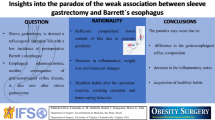Abstract
Lynch syndrome (LS), the most common hereditary cause of colorectal cancer, predisposes to upper gastrointestinal neoplasia. The prevalence of Barrett’s esophagus (BE) is elevated in some hereditary gastrointestinal cancer syndromes but has not been systematically evaluated in LS. We assessed the prevalence of BE, BE-related dysplasia, esophageal adenocarcinoma (EAC), and factors associated with BE in LS. Asymptomatic patients with a germline pathogenic variant (PV) in the DNA mismatch repair (MMR) genes undergoing EGD for LS surveillance were identified from a hereditary colorectal cancer registry. We assessed the prevalence of BE and compared demographic, clinical, and endoscopic factors in LS patients with and without BE by logistic regression analysis. 323 patients were included. 21 patients (6.5%) were diagnosed with BE including 38% of females and 33% without gastroesophageal reflux disease (GERD). Dysplasia was diagnosed in two patients (9.5%) and EAC in one (4.8%) patient. Factors associated with BE included male gender (OR 3.00, 1.21–7.46), age at last LS EGD (OR 1.04, 1.01–1.08), presence of hiatal hernia (OR 20.09, 4.57–88.23), hiatal hernia > 3 cm (OR 11.25, 2.41–51.94), and GERD (OR 3.39, 1.32–8.67). No MMR PV was associated with BE. BE was diagnosed in 1 of 15 patients undergoing EGD surveillance for LS and nearly 10% had dysplasia including one EAC. Risk factors associated with BE in LS are similar to those established for BE in the general population. More studies are needed to evaluate if an association between BE and LS exists.


Similar content being viewed by others
Data availability
The datasets generated during and/or analyzed during the current study are available from the corresponding author on reasonable request.
Abbreviations
- BE:
-
Barrett’s esophagus
- BMI:
-
Body mass index
- EAC:
-
Esophageal adenocarcinoma
- EGD:
-
Esophagogastroduodenoscopy
- FAP:
-
Familial adenomatous polyposis
- GERD:
-
Gastroestophageal reflux disease
- LS:
-
Lynch Syndrome
- MMR:
-
Mismatch repair
- MSI:
-
Microsatellite instability
- MAP:
-
MUTYH-associated polyposis
- NSAID:
-
Non-steroidal anti-inflammatory drug
- OR:
-
Odds ratio
- PPI:
-
Proton pump inhibitor
- PV:
-
Pathogenic variant
- US:
-
United States
References
Lynch HT, Snyder CL, Shaw TG et al (2015) Milestones of Lynch syndrome: 1895–2015. Nat Rev Cancer 15(3):181–194. https://doi.org/10.1038/nrc3878
Bonadona V, Bonaïti B, Olschwang S et al (2011) Cancer risks associated with germline mutations in MLH1, MSH2, and MSH6 genes in Lynch syndrome. JAMA 305(22):2304–2310. https://doi.org/10.1001/jama.2011.743
National Comprehensive Cancer Network (2020). Genetic/familial high-risk assessment: colorectal. Available from: https://www.nccn.org/professionals/physician_gls/pdf/genetics_colon.pdf
Farha N, Hrabe J, Sleiman J et al (2021) Clinically actionable findings on surveillance EGD in asymptomatic patients with Lynch syndrome. Gastrointest Endosc. 95:105–114. https://doi.org/10.1016/j.gie.2021.07.004
Sweetser S, Chandan VS, Baron TH. Dysphagia in Lynch syndrome. Gastroenterology. 2013 Nov;145(5):945, 1167–8. doi: https://doi.org/10.1053/j.gastro.2013.08.006. Epub 2013 Sep 25. PMID: 24075947.
Sasaki H, Yamashita K, Nakase H. Pedunculated Upper Esophageal Adenocarcinoma in Lynch Syndrome. Clin Gastroenterol Hepatol. 2019 Apr;17(5):A20. doi: https://doi.org/10.1016/j.cgh.2018.06.008. Epub 2018 Aug 4. PMID: 30086273.
Farha N, Savage E, Sleiman J, Burke CA. Using Immunohistochemistry to Expand the Spectrum of Lynch Syndrome-Related Tumors. ACG Case Rep J. 2021;8(11):e00691. Published 2021 Nov 3. doi:https://doi.org/10.14309/crj.0000000000000691
Daans CG, Ghorbanoghli Z, Velthuizen ME et al (2020) Increased prevalence of Barrett’s esophagus in patients with MUTYH-associated polyposis (MAP). Fam Cancer 19(2):183–187. https://doi.org/10.1007/s10689-020-00162-9
Gatalica Z, Chen M, Snyder C, Mittal S, Lynch HT (2014) Barrett’s esophagus in the patients with familial adenomatous polyposis. Fam Cancer 13(2):213–217. https://doi.org/10.1007/s10689-013-9638-7
Kumar S, Dudzik CM, Reed M, Long JM, Wangensteen KJ, Katona BW (2020) Upper Endoscopic Surveillance in Lynch Syndrome Detects Gastric and Duodenal Adenocarcinomas. Cancer Prev Res (Phila) 13(12):1047–1054. https://doi.org/10.1158/1940-6207.CAPR-20-0269
Cook MB, Thrift AP (2021) Epidemiology of Barrett’s Esophagus and Esophageal Adenocarcinoma: Implications for Screening and Surveillance. Gastrointest Endosc Clin N Am 31(1):1–26. https://doi.org/10.1016/j.giec.2020.08.001
Andrici J, Tio M, Cox MR, Eslick GD (2013) Hiatal hernia and the risk of Barrett’s esophagus. J Gastroenterol Hepatol 28(3):415–431. https://doi.org/10.1111/j.1440-1746.2012.07199
Eusebi LH, Cirota GG, Zagari RM, Ford AC (2021) Global prevalence of Barrett’s oesophagus and oesophageal cancer in individuals with gastro-oesophageal reflux: a systematic review and meta-analysis. Gut 70(3):456–463. https://doi.org/10.1136/gutjnl-2020-321365
Wani S, Falk G, Hall M et al (2011) Patients with nondysplastic Barrett’s esophagus have low risks for develo** dysplasia or esophageal adenocarcinoma. Clin Gastroenterol Hepatol 9(3):220-e26. https://doi.org/10.1016/j.cgh.2010.11.008
Funding
None.
Author information
Authors and Affiliations
Contributions
Study conception and design: CAB, NF; Acquisition of data: NF; Interpretation of data: CAB, NF; Drafting of manuscript: NF, CAB; Critical revision: DL, AB, CM, CAB; Statistical Analysis: RL; Study Supervision: CAB.
Corresponding author
Ethics declarations
Conflicts of interest
No potential conflicts (financial, professional, or personal) to disclose by all the authors.
Ethical approval
Approved.
Consent to participate
Informed consent was obtained from all individual participants.
Consent for publication
Informed consent was obtained from all individual participants.
Additional information
Publisher's Note
Springer Nature remains neutral with regard to jurisdictional claims in published maps and institutional affiliations.
Rights and permissions
About this article
Cite this article
Farha, N., Lyu, R., Liska, D. et al. Prevalence and risk factors of barrett’s esophagus in lynch syndrome. Familial Cancer 22, 55–60 (2023). https://doi.org/10.1007/s10689-022-00298-w
Received:
Accepted:
Published:
Issue Date:
DOI: https://doi.org/10.1007/s10689-022-00298-w




